A Coupled Modeling Approach for Water Management in a River–Reservoir System
Abstract
:1. Introduction
2. Materials and Methods
2.1. Study Area
2.2. Model Description
2.2.1. Watershed Model—HSPF
2.2.2. EFDC Model in Riverine System
2.3. Model Configuration
2.4. Model Calibration and Validation
2.5. Scenarios Development
3. Results
3.1. Calibration and Validation Results
3.2. Seasonal Variation of Water Quality (Scenario 1)
3.3. Sensitivity to Pollutant Export from the Gutian River (Scenario 2)
3.4. Effect of the Farming Cage (Scenario 3)
4. Discussions
4.1. Effectiveness of the Coupled Model
4.2. Scenarios Analysis for Delineating Nutrient Rate in the River-Reservoir System
4.3. Management Implications
4.4. Limitation and Next Agenda
5. Conclusions
Supplementary Materials
Author Contributions
Funding
Acknowledgments
Conflicts of Interest
References
- Chen, L.; Yang, Z.; Liu, H. Assessing the eutrophication risk of the Danjiangkou reservoir based on the EFDC model. Ecol. Eng. 2016, 96, 117–127. [Google Scholar] [CrossRef]
- Zhang, J.; Wei, Z.; Jia, H.F.; Huang, X. Factors influencing water quality indices in a typical urban river originated with reclaimed water. Front. Environ. Sci. Eng. 2017, 11, 8. [Google Scholar] [CrossRef]
- Gao, Q.F.; He, G.J.; Fang, H.W.; Bai, S.; Huang, L. Numerical simulation of water age and its potential effect on the water quality in Xiangxi Bay of Three Gorges Reservoir. J. Hydrol. 2018, 566, 484–499. [Google Scholar] [CrossRef]
- Chen, H.; Xiao, F.; Bi, Z.; Xiao, P.; Wang, D.S.; Yang, M. Practical evaluation for water utilities in China by using analytic hierarchy process. Front. Environ. Sci. Eng. 2015, 9, 131–137. [Google Scholar] [CrossRef]
- Han, Z.X.; Shen, Z.Y.; Gong, Y.W.; Hong, Q. Temporal dimension and water quality control in an emission trading scheme based on water environmental functional zone. Front. Environ. Sci. Eng. 2011, 5, 119–129. [Google Scholar] [CrossRef]
- Felzer, B. Nitrogen, and water response to climate and land use changes in Pennsylvania during the 20th and 21st centuries. Ecol. Modell. 2012, 240, 49–63. [Google Scholar] [CrossRef]
- Zhou, P.; Huang, J.L.; Hong, H.S. Modeling nutrient sources, transport and management strategies in a coastal watershed, Southeast China. Sci. Total Environ. 2018, 610, 1298–1309. [Google Scholar] [CrossRef] [PubMed]
- Hamrick, J.M.A. Three-Dimensional Environmental Fluid Dynamics Computer Code: Theoretical and Computational Aspect; The College of William and Mary: Williamsburg, VA, USA, 1992. [Google Scholar]
- Hamrick, J.M.; Wu, T.S. Computational Design and Optimization of the Efdc/Hem3d Surface Water Surface Water Hydrodynamic and Eutrophication Models; Society for Industrial and Applied Mathematics: Philadelphia, PA, USA, 1997. [Google Scholar]
- Li, H.M.; Tang, H.J.; Shi, X.Y.; Zhang, C.S.; Wang, X.L. Increased nutrient loads from the Changjiang (Yangtze) River have led to increased harmful algal blooms. Harmful Algae 2014, 39, 92–101. [Google Scholar] [CrossRef]
- Wang, Q.; Li, S.; Jia, P.; Qi, C.; Ding, F. A review of surface water quality model. Sci. World J. 2013, 3, 231768. [Google Scholar] [CrossRef]
- Du, P.F.; Li, Z.Y.; Huang, J.L. A modeling system for drinking water sources and its application to Jiandong Reservoir in Xiamen City. Front. Environ. Sci. Eng. 2013, 7, 735–747. [Google Scholar] [CrossRef]
- Chen, L.; Yang, Y.; Chen, J.; Gao, S.H.; Qi, S.S.; Sun, C.; Shen, Z.Y. Spatial-temporal variability and transportation mechanism of polychorinated biphenyls in the Yangtze River Estuary. Sci. Total Environ. 2017, 598, 12–20. [Google Scholar] [CrossRef] [PubMed]
- Huang, J.C.; Qi, L.Y.; Gao, J.F.; Kim, D.K. Risk assessment of hazardous material loading into four large lakes in China: A new hydrodynamic indicator based on EFDC. Ecol. Indic. 2017, 80, 23–30. [Google Scholar] [CrossRef]
- Du, J.B.; Shen, J.; Park, K.; Wang, Y.P.; Yu, X. Worsened physical condition due to climate change contributes to the increasing hypoxia in Chesapeake Bay. Sci. Total Environ. 2018, 630, 707–717. [Google Scholar] [CrossRef] [PubMed]
- Huang, S.F.; Zang, W.B.; Xu, M.; Li, X.T.; Xie, X.C.; Li, M.Z.; Zhu, J.S. Study on runoff simulation of the upstream of Minjiang River under future climate change scenarios. Nat. Hazards 2015, 75, 139–154. [Google Scholar] [CrossRef]
- Hung, J.L.; Zhou, P.; Zhou, Z.R.; Huang, Y.L. Assessing the influence of land use and land cover datasets with different points in time and levels of detail on watershed modeling in the North River Watershed, China. Int. J. Environ. Res. Public Health 2013, 10, 144–157. [Google Scholar] [CrossRef] [PubMed]
- Maharjan, G.R.; Park, Y.S.; Kim, N.W.; Shin, D.S.; Choi, J.W.; Hyun, G.W.; Jeon, J.H.; Ok, Y.S.; Lim, K.J. Evaluation of SWAT sub-daily runoff estimation at small agricultural watershed in Korea. Front. Environ. Sci. Eng. 2013, 7, 109–119. [Google Scholar] [CrossRef]
- Kim, J.J.; Ryu, J.H. Modeling hydrological and environmental consequences of climate change and urbanization in the Boise River Watershed, Idaho. J. Am. Water Resour. Assoc. 2018, 55, 133–153. [Google Scholar] [CrossRef]
- Choi, W.; Pan, F.; Wu, C. Impact of climate change and urban growth on the streamflow of the Milwaukee River (Wisconsin, USA). Reg. Environ. Change 2017, 17, 889–899. [Google Scholar] [CrossRef]
- Hunag, J.C.; Gao, J.F.; Yan, R.H. How can we reduce phosphorus export from lowland polders? Implications from a sensitivity analysis of coupled model. Sci. Total Environ. 2016, 562, 946–952. [Google Scholar] [CrossRef]
- Cai, Y.P.; Cai, J.Y.; Xu, L.Y.; Tan, Q.; Xu, Q. Integrated risk analysis of water-energy nexus systems based on a system dynamics, orthogonal design and copula analysis. Renew. Sustsin. Energy Rev. 2019, 99, 125–137. [Google Scholar] [CrossRef]
- Chen, W.J.; He, B.; Nover, D.; Lu, H.; Liu, J.; Sun, W.; Chen, W. Farm ponds in southern China: Challenges and solutions for conserving neglected wetland ecosystem. Sci. Total Environ. 2019, 659, 1322–1334. [Google Scholar] [CrossRef] [PubMed]
- Huang, J.L.; Zhang, Z.Y.; Feng, Y.; Hong, H.S. Hydrologic response to climate change and human activities in a subtropical coastal watershed of southeast China. Reg. Environ. Change 2013, 13, 1195–1210. [Google Scholar] [CrossRef]
- Crawford, N.H.; Linsley, R.E. Digital simulation in hydrology: Stanford watershed model IV. Available online: https://trid.trb.org/view.aspx?id=99040 (accessed on 1 May 1994).
- Bicknell, B.R.; Imhoff, J.C.; Kittle, J.L.; Jobes, T.H.; Donigian, A.S. Hydrological Simulation Program-Fortran (HSPF). User’s Manual for Release 12.2; Environmental Protection Agency: Washington, DC, USA, 2005.
- Tech, T. The Environmental Fluid Dynamics Code Theory and Computation; Water Quality Model Theory and Computation: Williamsburg, VA, USA, 2007. [Google Scholar]
- Bai, H.; Chen, Y.; Wang, D.; Zou, R.; Zhang, H.Z.; Ye, R.; Ma, W.J.; Sun, Y.H. Developing an EFDC and numerical source-apportionment model for nitrogen and phosphorus contribution analysis in a lake basin. Water 2018, 10, 1315. [Google Scholar] [CrossRef]
- Zhao, F.; Li, C.H.; Chen, L.B.; Zhang, Y. An integrated method for accounting for water environmental capacity of the river-reservoir combination system. Water 2018, 10, 483. [Google Scholar] [CrossRef]
- Hou, J.W.; Ye, A.Z.; You, J.J.M.F.; Duan, Q.Y. An estimate of human and natural contributions to changes in water reources in the upper reaches of the Minjiang River. Sci. Total Environ. 2018, 635, 901–912. [Google Scholar] [CrossRef] [PubMed]
- Huang, J.L.; Huang, Y.L.; Zhang, Z.Y. Coupled effects of natural and anthropogenic controls on season and spatial variations of river water quality during baseflow in a coastal watershed of southeast China. PLoS ONE 2014, 9, e91528. [Google Scholar]
- Huang, J.L.; Huang, Y.L.; Pontius, R.G.; Zhang, Z.Y. Geographically weighted regression to measure spatial variations in correlations between water pollution versus land use in a coastal watershed. Ocean Coast. Manag. 2015, 103, 14–24. [Google Scholar] [CrossRef]
- Qi, H.D.; Lu, J.Z.; Chen, X.L.; Sauvage, S.; Sanchez-Perez, J. Water age prediction and its potential impacts on water quality using a hydrodynamic model for Poyang Lake, China. Environ. Sci. Pollut. Res. 2016, 23, 13327–13341. [Google Scholar] [CrossRef] [PubMed]
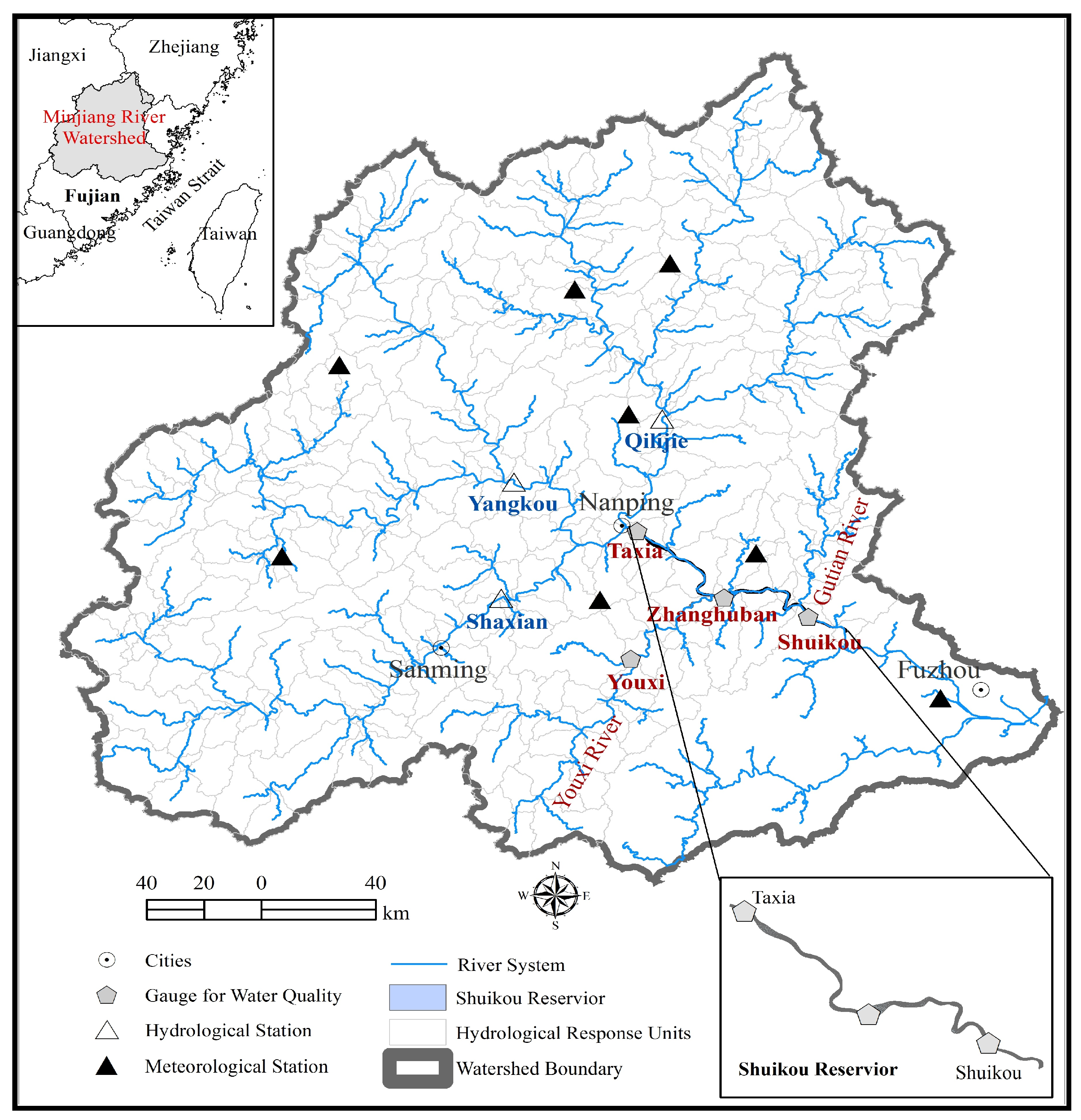
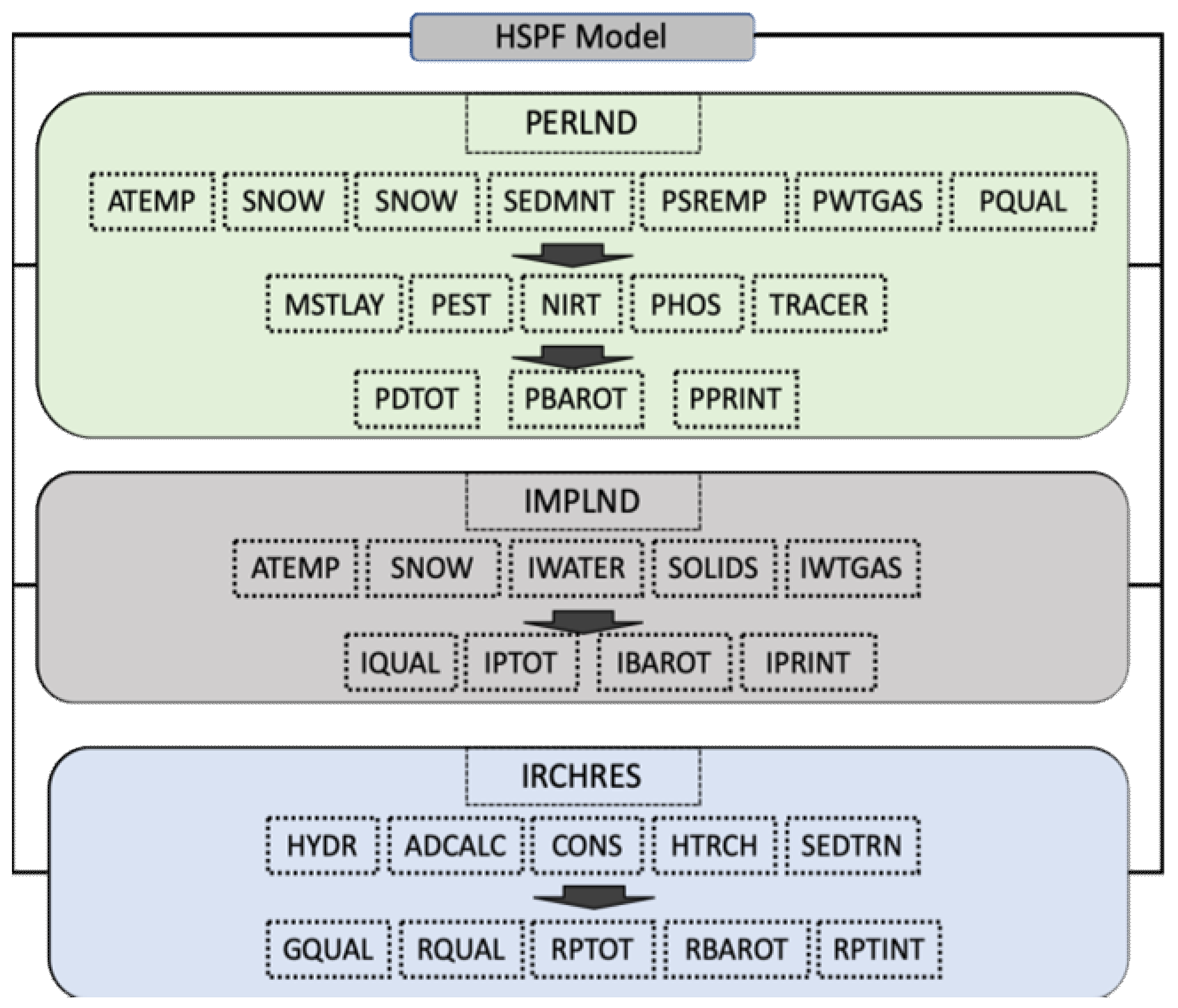
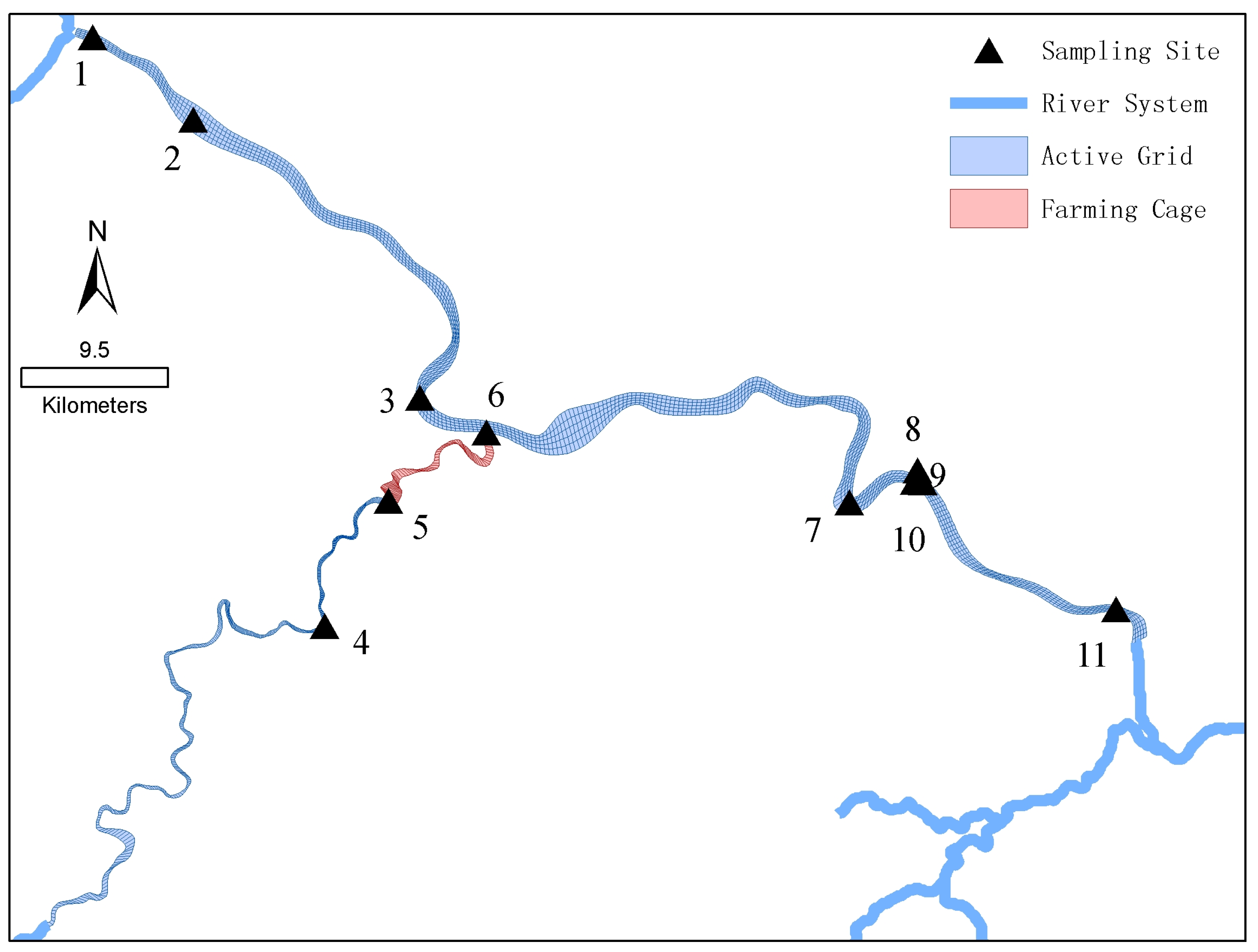
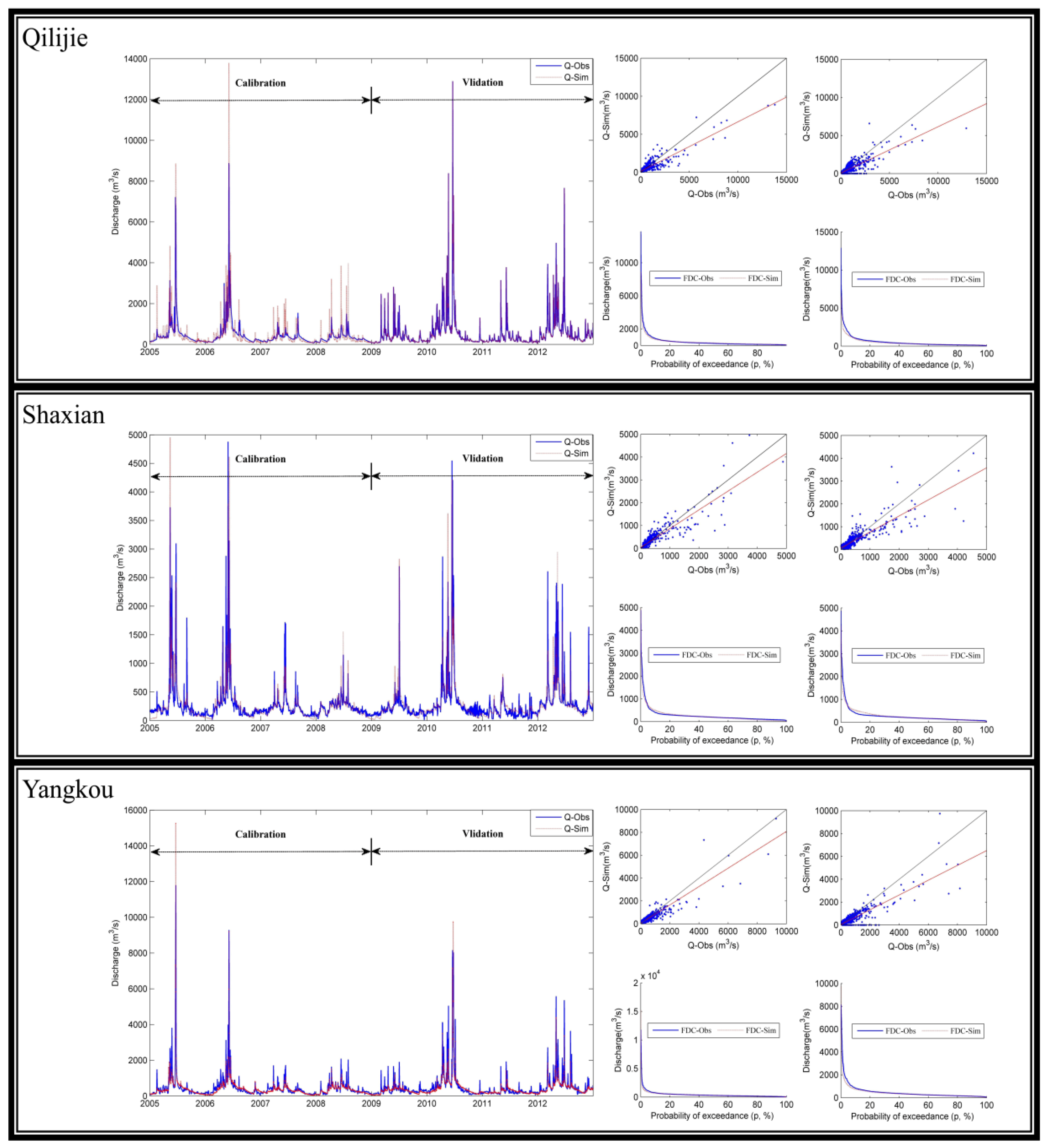
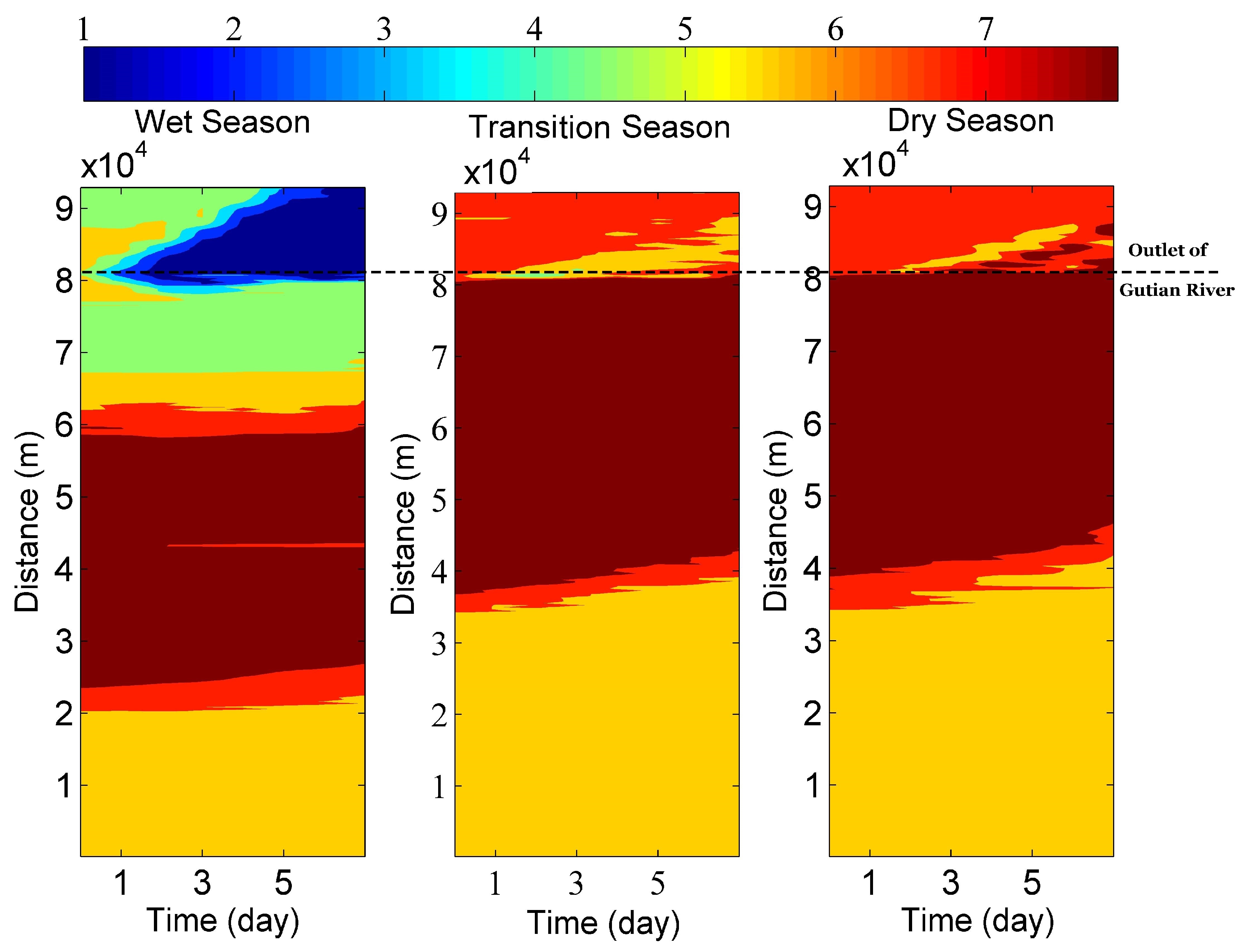
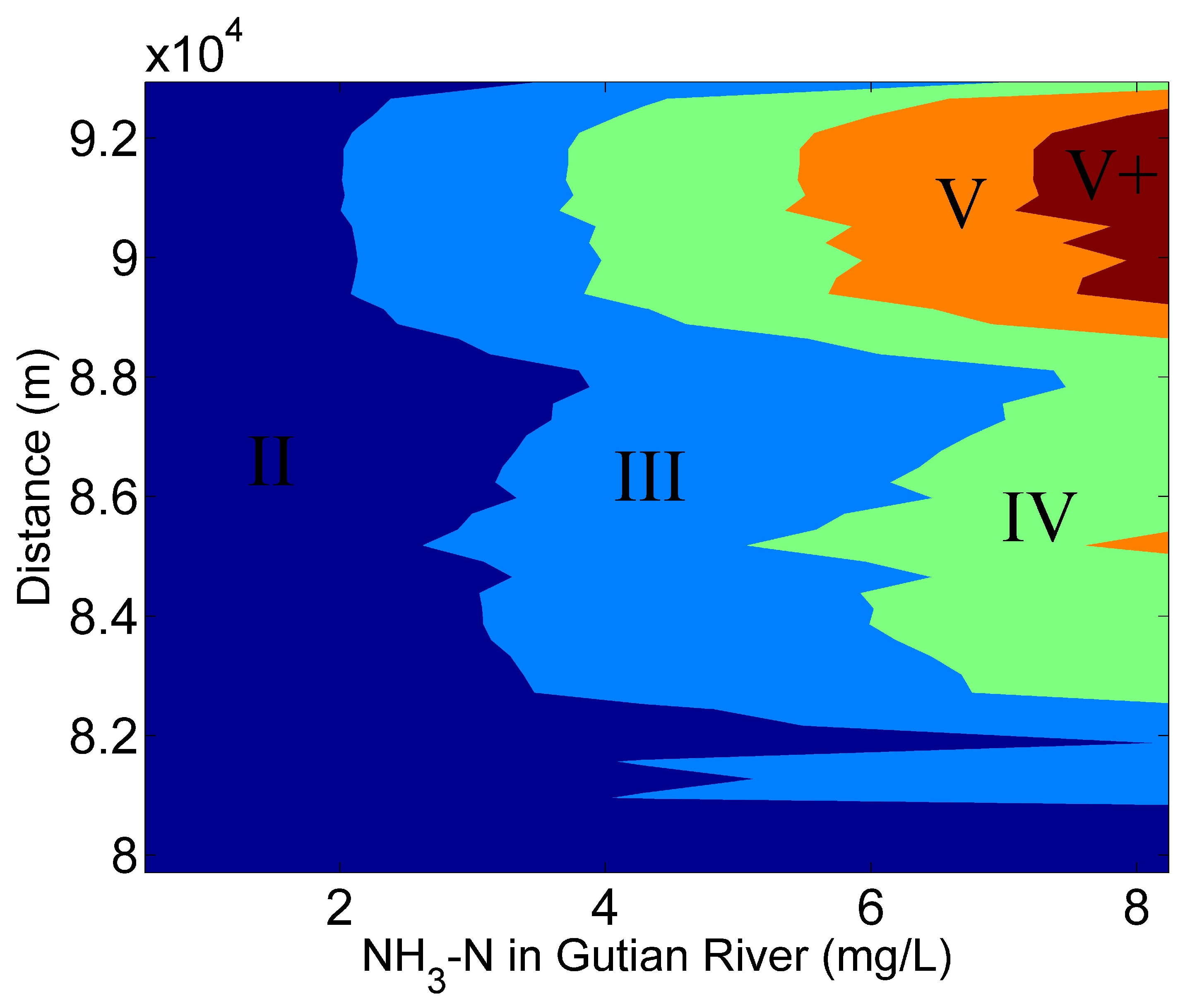
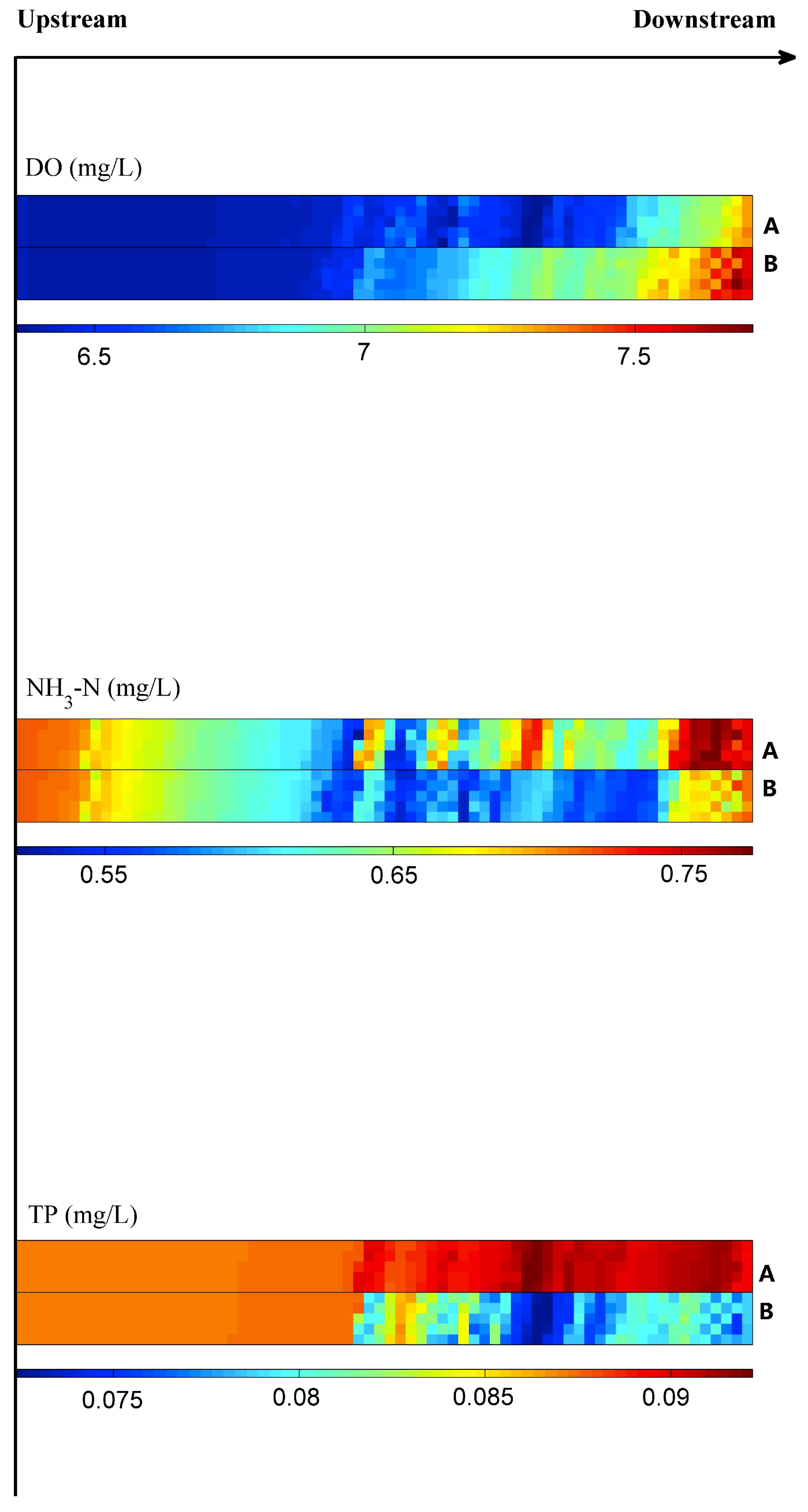
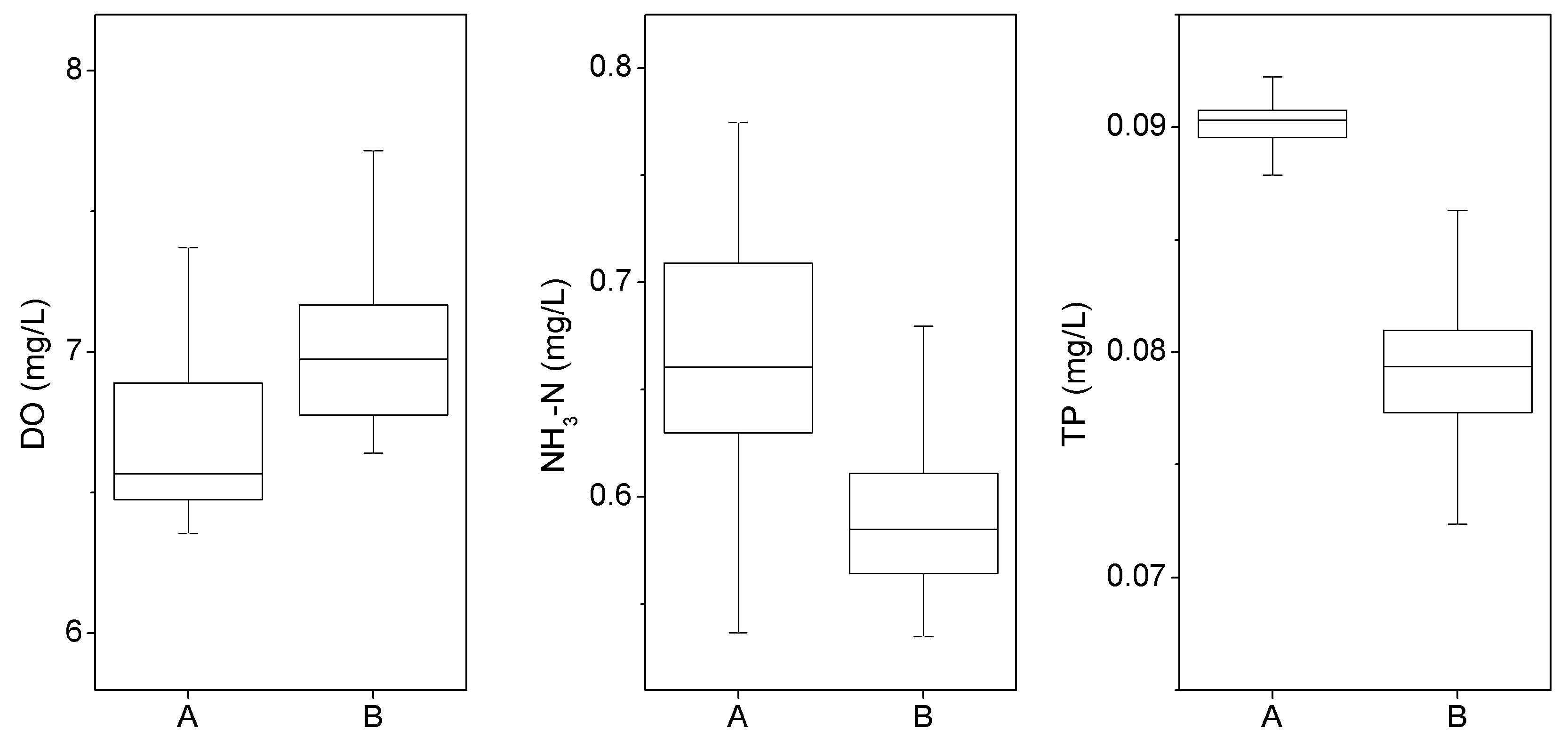
| Water Season | Period | Precipitation | Soil Condition | Temperature |
|---|---|---|---|---|
| Wet Season | Growth | V | III | IV |
| Transition Season | Growth | II | II | III |
| Dry Season | Dormancy | I | I | III |
| Classification | Precipitation (mm) | Temperature (°C) |
|---|---|---|
| I | 0 | 5–15 |
| II | 0.1–9.9 | 15–0 |
| III | 10–24.9 | 20–25 |
| IV | 25–49.9 | 25–35 |
| V | 50–99.9 | |
| VI | >100 |
| Classification | Precipitation Within 5 Days (mm) | |
|---|---|---|
| Growth Period (March to November) | Dormancy Period (December to February) | |
| I | <13 | <36 |
| II | 13–28 | 36–53 |
| III | >28 | >53 |
| Station | Calibration | Validation | ||
|---|---|---|---|---|
| NSE (Nash–Sutcliffe Coefficient of Efficiency) | R2 | NSE | R2 | |
| Shaxian | 0.784 | 0.787 | 0.745 | 0.751 |
| Yangkou | 0.774 | 0.779 | 0.782 | 0.809 |
| Qilijie | 0.782 | 0.817 | 0.737 | 0.772 |
| Stations | NH3-N | TP (Total Phosphorus) | ||
|---|---|---|---|---|
| Calibration | Validation | Calibration | Validation | |
| RE (Relative Error) | RE | RE | RE | |
| Shaxian | 0.50 | 0.51 | 0.32 | 0.30 |
| Yangkou | 0.34 | 0.42 | 0.50 | 0.33 |
| Qilijie | 0.32 | 0.54 | 0.49 | 0.30 |
| Stations | DO (Dissolved Oxygen) | NH3-N | TP | |||
|---|---|---|---|---|---|---|
| Calibration | Validation | Calibration | Validation | Calibration | Validation | |
| ME (Median Error) | ME | ME | ME | ME | ME | |
| Youxi | 0.001 | 0.027 | 0.003 | 0.0232 | 0.003 | 0.008 |
| Taxia | 0.012 | 0.001 | 0.072 | 0.002 | 0.080 | 0.001 |
| Zhanghuban | 0.243 | 0.143 | 0.705 | 0.298 | 0.438 | 0.326 |
| Shuikou | 0.331 | 0.266 | 0.327 | 0.388 | 0.295 | 0.296 |
© 2019 by the authors. Licensee MDPI, Basel, Switzerland. This article is an open access article distributed under the terms and conditions of the Creative Commons Attribution (CC BY) license (http://creativecommons.org/licenses/by/4.0/).
Share and Cite
Zhang, Z.; Huang, J.; Zhou, M.; Huang, Y.; Lu, Y. A Coupled Modeling Approach for Water Management in a River–Reservoir System. Int. J. Environ. Res. Public Health 2019, 16, 2949. https://doi.org/10.3390/ijerph16162949
Zhang Z, Huang J, Zhou M, Huang Y, Lu Y. A Coupled Modeling Approach for Water Management in a River–Reservoir System. International Journal of Environmental Research and Public Health. 2019; 16(16):2949. https://doi.org/10.3390/ijerph16162949
Chicago/Turabian StyleZhang, Zhenyu, Jinliang Huang, Min Zhou, Yaling Huang, and Yimin Lu. 2019. "A Coupled Modeling Approach for Water Management in a River–Reservoir System" International Journal of Environmental Research and Public Health 16, no. 16: 2949. https://doi.org/10.3390/ijerph16162949
APA StyleZhang, Z., Huang, J., Zhou, M., Huang, Y., & Lu, Y. (2019). A Coupled Modeling Approach for Water Management in a River–Reservoir System. International Journal of Environmental Research and Public Health, 16(16), 2949. https://doi.org/10.3390/ijerph16162949




